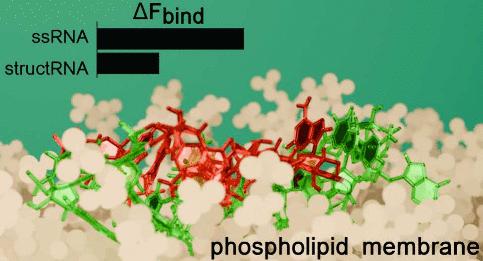全原子模拟阐明rna -膜相互作用的分子机制
IF 9.1
1区 材料科学
Q1 CHEMISTRY, MULTIDISCIPLINARY
引用次数: 0
摘要
rna -膜相互作用开始成为自然和合成生物系统中重要的组织力量。值得注意的是,最近发现RNA分子存在于活细胞的细胞外表面,在那里它们介导细胞间信号传导。此外,RNA -膜相互作用影响基于脂质的RNA传递系统的功效。然而,驱动RNA在膜上定位的分子术语仍然知之甚少。在这项工作中,我们通过全原子模拟研究了rna如何与磷脂膜结合和相互作用。我们发现在RNA核碱基中,由于广泛的氢键形成,鸟嘌呤表现出最有利的膜结合自由能。此外,我们发现RNA内碱基配对存在于有组织的RNA结构中,显著阻碍了RNA与膜的结合。阐明RNA-膜结合的分子细节将有助于改进基于RNA的药物和基于脂质的RNA传递系统的设计,并解析RNA的转运和定位机制。本文章由计算机程序翻译,如有差异,请以英文原文为准。

All-Atom Simulations Elucidate the Molecular Mechanism Underlying RNA–Membrane Interactions
RNA–membrane interactions are starting to emerge as an important organizing force in both natural and synthetic biological systems. Notably, RNA molecules were recently discovered to be present on the extracellular surface of living cells, where they mediate intercellular signaling. Furthermore, RNA–membrane interactions influence the efficacy of lipid-based RNA delivery systems. However, the molecular terms driving RNA localization at the membrane remain poorly understood. In this work, we investigate how RNAs bind and interact with phospholipid membranes via all-atom simulations. We find that among RNA nucleobases guanine exhibits the most favorable membrane binding free energy due to extensive hydrogen bond formation. Additionally, we show that intra-RNA base pairing, present in organized RNA structures, significantly hinders RNA–membrane binding. Elucidating the molecular details of RNA–membrane association will importantly contribute to improving the design of RNA-based drugs as well as lipid-based RNA delivery systems and to parsing out RNA transport and localization mechanisms.
求助全文
通过发布文献求助,成功后即可免费获取论文全文。
去求助
来源期刊

Nano Letters
工程技术-材料科学:综合
CiteScore
16.80
自引率
2.80%
发文量
1182
审稿时长
1.4 months
期刊介绍:
Nano Letters serves as a dynamic platform for promptly disseminating original results in fundamental, applied, and emerging research across all facets of nanoscience and nanotechnology. A pivotal criterion for inclusion within Nano Letters is the convergence of at least two different areas or disciplines, ensuring a rich interdisciplinary scope. The journal is dedicated to fostering exploration in diverse areas, including:
- Experimental and theoretical findings on physical, chemical, and biological phenomena at the nanoscale
- Synthesis, characterization, and processing of organic, inorganic, polymer, and hybrid nanomaterials through physical, chemical, and biological methodologies
- Modeling and simulation of synthetic, assembly, and interaction processes
- Realization of integrated nanostructures and nano-engineered devices exhibiting advanced performance
- Applications of nanoscale materials in living and environmental systems
Nano Letters is committed to advancing and showcasing groundbreaking research that intersects various domains, fostering innovation and collaboration in the ever-evolving field of nanoscience and nanotechnology.
 求助内容:
求助内容: 应助结果提醒方式:
应助结果提醒方式:


